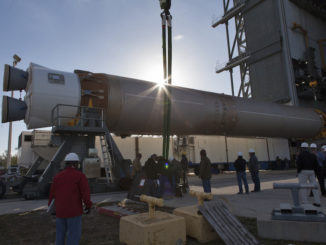CAPE CANAVERAL — Perspectives of Friday’s United Launch Alliance Atlas 5 rocket flight were snapped from a commercial airliner, a satellite observer in Australia and the booster itself.
I flew by a rocket taking off pic.twitter.com/VDqkVfPej8
— Ryan Kennedy (@Imagineer6) June 24, 2016
Passenger Ryan Kennedy had a window seat aboard the south-bound Southwest Airlines flight and witnessed the Atlas 5 rocket arcing to space with the Navy’s MUOS 5 mobile communications satellite.
“The people on the other side of the plane were PISSED,” he tweeted.
The aircraft was just west of the Cape Canaveral pad, offering a spectacular view of the rocket’s trajectory following the 10:30 a.m. EDT (1430 GMT) liftoff.
Over three hours later, after performing three firings to reach a customized high-perigee geosynchronous transfer orbit, the Centaur upper stage released the Mobile User Objective System satellite.
Beautiful image of #MUOS 5 and its Centaur venting fuel, made by Paul Camilleri in Warners bay, Australia, ~18:03 UT pic.twitter.com/Tz81OwPOGR
— Dr Marco Langbroek (@Marco_Langbroek) June 24, 2016
‘
A novice satellite-watcher in Australia, Paul Camilleri,who was the first to discover the Delta 4-Heavy’s clandestine payload in geosynchronous orbit over the Indian Ocean two weeks earlier, snapped an incredible picture of Centaur and MUOS 5.
Centaur was in the midst of dumping its reserve fuels to pacify and safe the upper stage about 40 minutes after deploying the 15,000-pound satellite.
The duo was more than 20,000 miles above the Indian Ocean at the time, just off the northwestern coast of Australia.
And video cameras about the rocket itself dealt spectacular views of the vehicle unleashing two-and-a-half million pounds of thrust as it blasted away from Complex 41.
Powered by its kerosene main engine and five solid rocket boosters, the Atlas 5 left the pad in a hurry. The Florida coastline quickly comes into view, along with Kennedy Space Center’s Complex 39, Vehicle Assembly Building and Shuttle Landing Facility runway.
Straight off the pad, the vehicle executed a roll maneuver to obtain the proper ascent profile and minimize aerodynamic loads. The solids burned for 90 seconds, followed 20 seconds later by jettisoning in two batches.
The video continues with separation of the 18-foot-diameter composite nose cone and the spent first stage falling away from Centaur.
The three ignitions by the RL10C-1 engine on the Centaur illustrate the sequential approach to reaching the planned MUOS deploy orbit, initially reaching a parking orbit, then a highly elliptical orbit and the high-perigee GTO.
The onboard video concludes with release of MUOS 5 to complete the Navy’s new global smartphone satellite constellation.
See earlier MUOS 5 coverage.
Our Atlas archive.



